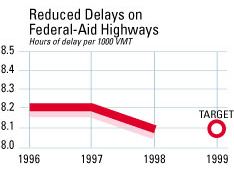| Connecting America - 1999 Report to the Nation | 10 of 16 |
ProductivityContinuously improve the economic efficiency of the nation's transportation system to enhance America's position in the global economy.Transportation accounts for nearly 11 percent of our nation's gross domestic product. In our increasingly intermodal transportation network, highways are crucial in almost all freight movements, serving as connectors to water, rail, and air facilities. Approximately 70 percent of all freight is transported over our highways. At an average hourly operating cost of $40 to $60 for long-haul vehicle operations, disruptions can be costly to carriers and shippers--and ultimately, to the consumer. Delays on Federal-Aid Highways Measure for Success: Reduce delays on federal-aid highways.
 Delays are costly. It is estimated that more than $50 billion a year is spent on lost productivity and wasted fuel. In the Mobility section, we talked about travel time delays in urban areas. FHWA also monitors travel delays across the entire federal-aid highway system, which includes roadways that connect cities, suburbs, and rural areas. Unlike in urban areas, travel time delays through the entire system have dropped slightly over the past three years. The decrease in delays is due, in part, to efforts to help motorists traveling through work zones, toll plazas, and truck weigh and inspection stations. For example, we work with our partners to support the National Work Zone Safety Information Clearinghouse. It provides information to help motorists on work zone-related topics and actually indicates the location of work zones and road closures. By accessing this database, motorists can plan their travel routes to avoid delays. We also fund ITS technologies that provide real-time weather and road condition information to help motorists plan their travel routes; automated toll plazas; and automated weigh and inspection stations to minimize travel delays. NHS Intermodal Connections Transportation of goods is a key indicator in the U.S. economy and an influential element in the overall competitiveness of the United States worldwide. As sites of manufacturing become globally mobile and national economies begin to merge into a world market, shippers and carriers are operating in an increasingly competitive market. FHWA continuously examines how to make the highway system more productive. In 1998, FHWA initiated a major study to evaluate the condition of NHS intermodal connections. FHWA is establishing targets and collecting periodic data. This data should guide our efforts in enhancing the efficiency and capacity of intermodal connectors. Congestion on NHS Border Crossings Truck traffic to and from Canada and Mexico is expected to grow with an expanding economy, straining the existing capacity. Processing vehicles through U.S. ports of entry can be very complex and time-consuming. The efficient movement of trucks must be balanced with vehicle safety and immigration and customs requirements. With its partners, FHWA is deploying ITS technologies at border-crossing sites. Working with the Department of Treasury and U.S. Customs, we have put ITS to work delivering registration and safety information about vehicles to customs agents at border compounds. This speeds up the information-gathering process so congestion and delays are notably decreased.
AccomplishmentsITS--It's Working for YouIn at least 21 states, electronic clearance is cutting the time trucks spend at weigh stations. The wider use of electronic transponders in commercial vehicles adds up to an approximate savings of $8.6 million a year per state. In addition, a study of real-time diversion of truckload carriers predicts an additional productivity improvement of 6 percent. In Minnesota's Mankato highway district, snow is piled so deep on a 17-mile stretch of State Highway 19 that snowplows often missed the roadbed completely. Newly installed magnetic tape in the pavement directs sensor equipped snowplows onto snow-covered roads, helping keep roads clear and traffic moving. Not only has ITS been successful in metropolitan areas, we have seen great results in rural settings such as in Acadia National Park in Maine, the eighth most visited park in the United States. Acadia is a microcosm of the congestion and environmental concerns in our national parks. In addition to providing information on planning a trip, ITS at Acadia gives transportation options to those already in the park. It provides real-time monitoring of all conditions. Visitors are encouraged to ride the new shuttle system, thereby helping to reduce air pollution and congestion. ITS has enhanced safety, mobility, and access at Acadia, while protecting the park's fragile ecosystem. CVISN--Inspections on the GoCVISN (Commercial Vehicle Information Systems and Networks) is a joint private-public venture. It allows information systems and communication networks owned and operated by federal and state governments, motor carriers, and other stakeholders to operate in an integrated manner. As a result, safe and legal trucks and buses can be cleared electronically at traveling speeds without requiring them to stop for inspection. The deployment of CVISN will streamline the commercial vehicle credentialing and regulatory systems and enhance the efficiency of the trucking and motorcoach industries. For example, motor carriers can electronically apply for and receive interstate operating credentials, such as registration and fuel tax payment, by using their own computer systems.
|
|
Related Links: |